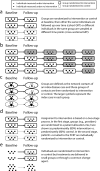Review of Recent Methodological Developments in Group-Randomized Trials: Part 1-Design
- PMID: 28426295
- PMCID: PMC5425852
- DOI: 10.2105/AJPH.2017.303706
Review of Recent Methodological Developments in Group-Randomized Trials: Part 1-Design
Abstract
In 2004, Murray et al. reviewed methodological developments in the design and analysis of group-randomized trials (GRTs). We have highlighted the developments of the past 13 years in design with a companion article to focus on developments in analysis. As a pair, these articles update the 2004 review. We have discussed developments in the topics of the earlier review (e.g., clustering, matching, and individually randomized group-treatment trials) and in new topics, including constrained randomization and a range of randomized designs that are alternatives to the standard parallel-arm GRT. These include the stepped-wedge GRT, the pseudocluster randomized trial, and the network-randomized GRT, which, like the parallel-arm GRT, require clustering to be accounted for in both their design and analysis.
Figures

References
-
- Murray DM. Design and Analysis of Group-Randomized Trials. New York, NY: Oxford University Press; 1998.
-
- Hayes RJ, Moulton LH. Cluster Randomised Trials. Boca Raton, FL: CRC Press; 2009.
-
- Donner A, Klar N. Design and Analysis of Cluster Randomization Trials in Health Research. London, England: Arnold; 2000.
-
- Eldridge S, Kerry S. A Practical Guide to Cluster Randomised Trials in Health Services Research. Chichester, UK: Wiley; 2012.
-
- Campbell MJ, Walters SJ. How to Design, Analyse and Report Cluster Randomised Trials in Medicine and Health Related Research. Chichester, UK: Wiley; 2014.
Publication types
MeSH terms
Grants and funding
LinkOut - more resources
Full Text Sources
Other Literature Sources
Research Materials
Miscellaneous

